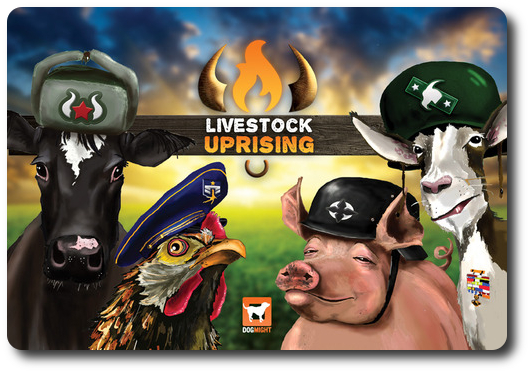
The Basics:
- For ages 10+ (publisher suggests 14+)
- For 2 to 4 players
- Approximately 120 minutes to complete
Geek Skills:
- Counting & Math
- Logical & Critical Decision Making
- Reading
- Strategy & Tactics
- Hand/Resource Management
- Worker Placement & Area Control
Learning Curve:
- Child – Easy
- Adult – Easy
Theme & Narrative:
- Rule the farm, rule the world
Endorsements:
- Gamer Geek approved!
- Parent Geek mixed!
- Child Geek rejected!
Overview
When the Pigs invaded the Chicken’s coop, it was just the beginning. Soon the Goats were involved, followed by the Cows. The farm was at total war with itself and every animal was forced to pick a side. The generals of each army believed victory was as good as theirs, but only if they could control the fields. This farm has gone to the animals and these animals have artillery.
Livestock Uprising, designed by Mike Cameron and published by Dog Might Games, is comprised of 12 General cards (3 per faction), 50 Troop cards, 12 Special Forces cards (3 per faction), 18 Command cards, 8 Battle Plan cards, 12 Army tokens (3 per player), 64 Board tiles, 125 Resource tokens, 4 Faction boards (double-sided, 1 per player), 4 Super Army tokens (1 per faction), and 4 standard six-sided dice. The cards are as thick as your standard playing cards. The tiles, tokens, and boards are all made of thick cardboard. The illustrations of the various animals, by artist Michael C. Konas, reminds me of what I pictured in my head when I read George Orwell‘s Animal Farm. That is to say, farm animals wearing highly militant fascist garb.
Game Set Up
To set up the game, first allow each player to select an animal faction of their choice. There are 4 to select from. These are the Pigs, the Goats, the Cows, and the Chickens. Then give each player their Faction board, General cards, Special Forces cards, Army tokens, Super Army token, and “Barn” Board tile that belongs to their selected faction.
Second, shuffle the Command cards and deal 3 to each player. These cards should be placed with the player’s General and Special Forces cards for a total of 9 cards. Any remaining Command cards are removed for the duration of the game.
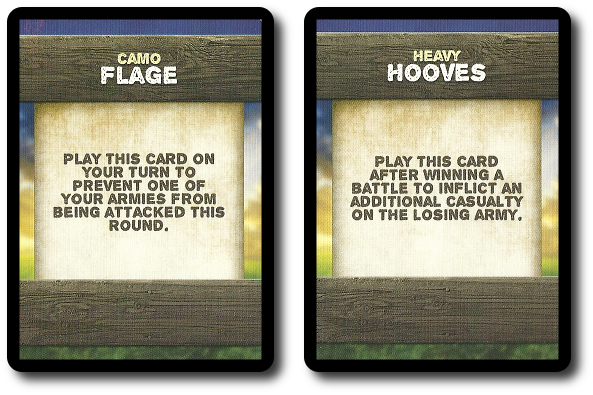
Third, have each player place their Faction board in front of them and their 3 General cards face-up below their Faction board. Make sure the side that lists Troops and Special Forces is face up. The only cards that should now be left in the player’s hand are the 3 Special Forces cards and the 3 Command cards.

Fourth, go through the Board tiles and remove any that should not be used based on the number of players. Each Board tile has a number of it (2 through 4) that indicates how many players need to be present in order for it to be used. For example, a 2-player game would only use Board tiles with a “2” value. In a 3-player game, players would use Board tiles with a “2” and “3” value. Any Board tiles not used are removed for the duration of the game.
Fifth, randomly select Board tiles and build the initial playing area. The number of Board tiles used is based on the number of players. For example, in a 3-player game, the starting game board would be comprised of 9 Board tiles grouped in a 3×3 grid.
Sixth, each player places their “Barn” Board tile adjacent to any Board tile that makes up the starting game board. Diagonal placement is not allowed. Players can occupy the same side of the game board and be adjacent to each other, but I don’t recommend it.
Eighth, the rest of the game board is now filled in by randomly selecting Board tiles and placing them on the perimeter of the grid. Again, the size of the game board will depend on the number of players. For example, the final size of the game board for 3-players is a 7×7 grid, but for a 2-player game the final size is only 5×5.
Ninth, each player now takes their 3 Army tokens and places them on their “Barn” Board tile.
Tenth, gather the Resource tokens and place them in a single pile. This is the Resource pool for the duration of the game. Shuffle the Battle Plan cards and place them face-down to one side of the game board. Take the Troop cards and place them in a pile face-up.
That’s it for game set up. Determine who will go first and begin.
War on the Farm
Livestock Uprising is played in turns with no set number of turns per game. A player’s turn consists of 3 phases. Once a player’s turn is over, the next player in turn order sequence goes. A player’s turn is summarized here. During the player’s turn, they can use their Command cards. These cards provide new rules that bend or break the general rules for a very short time. Once the Command card is used, it’s discarded. A few of the Command cards can be played out-of-turn, as well.
Phase 1: Action
Each player starts the game with 3 Army tokens. Each Army token represents 1 General in the player’s animal army. During this phase, the player will either move or move and attack using their Army tokens. A player is never required to use all 3 of their Army tokens during this phase, but each Army token can only be used once.
Move Action
Each Army token can be moved 2 squares on the game board in any direction. Army tokens cannot move through or end their movement on friendly Army tokens, “Forest”, “Lake”, or opponent’s “Barn” Board tiles. Only 1 friendly Army token can occupy each Board tile, with the one exception being the player’s “Barn” Board tile, which can hold all the player’s Army tokens.
Move and Attack Action
If a player moves into a Board tile space occupied by an opponent’s Army token, an attack is triggered.
Combat is very straight forward. Each player involved in combat (usually only 1 attacker and 1 defender) adds the Attack Strength or Defense Strength of all their Troop and Special Forces cards attached to the Army token that is engaged in combat. A player cannot initiate an attack unless they have at least 1 Troop or 1 Special Forces card attached to their attacking Army token. Both players then roll 1 six-sided die each and add the rolled value to their Attack or Defense Strength. The total value is the player’s overall Attack or Defense Strength. The values are compared and the battle is resolved. Ground is won or lost, and casualties are accounted for.
- If the Attack and Defense Strength is equal, the battle results in a stale mate with players neither losing ground or suffering casualties.
- If the defender wins, both Army tokens stay in their original position, but the attacking player must select 1 Troop or Special Forces card attached to their Army token and discard it. Discarded Special Forces cards are removed from the game, but discarded Troop cards are returned to the Troop draw pile.
- If the attacker wins, the defending player must select 1 Troop or Special Forces card attached to their Army token and discard it. Then the defending player must move their Army token to any adjacent empty space as the victorious attacker moves into the space recently occupied by the defending player.

The red spaces result in an attack; the green spaces do not
When an Army token attacks another Army token that does not have any Troop or Special Forces cards attached, that Army token automatically loses any and all attacks, but are not removed from the game board. Instead, they are forced to move to an adjacent space. Only Super Armies can destroy other armies.
If a player attacks on their turn, they cannot move the attacking Army token after the battle is resolved other than to move into a space recently occupied by the defeated opponent.
Phase 2: Harvest
If a player’s Army token occupies a Board tile that has a Resource symbol, they may attempt to gather it. The resources available include grass, hay, corn, carrots, and apples. But simply occupying the space where the resource is found is not enough. With the exception of the grass resource (which can always be collected), all other resources must be harvested using a Troop card. A number of the animals depicted on the Troop cards will show a symbol that matches the resource symbol on the Board tile. This indicates that the Army token with the attached Troop card can gather the resource.

Each Army token can only gather 1 Resource token per player’s turn. When the player does gather a resource, the matching Resource token is collected from the Resource pool and placed in front of the player.
Phase 3: Marshaling
Resources are a form of currency in this game. Players spend Resource tokens to purchase cards and build up their army’s strength. There are 2 cards that can be purchased during this phase if the player can pay for them. These are Special Forces and Troop cards. Once a player spends their Resource tokens, they are put back in the Resource pool.
Troop Cards
Troop cards represent all the other animals on the farm that are involved in this war. They are not faction specific and can be claimed by any player. The player’s Faction board lists the cost (in Resource tokens) for each Troop card type. The most common and the only card the player will be able to get first is the “Sacrificial Sheep” Troop card that can be purchased for 2 “Grass” Resource tokens. Recall that grass is the only resource that can be harvested WITHOUT the use of a Troop card. Once the player has the “Sacrificial Sheep” Troop card, they can then gather hay. Once they have hay and grass, they can purchase the “Dynamite Donkey” Troop card. The Faction board lists all of this and acts as both a pricing guide and a development tree of sorts.
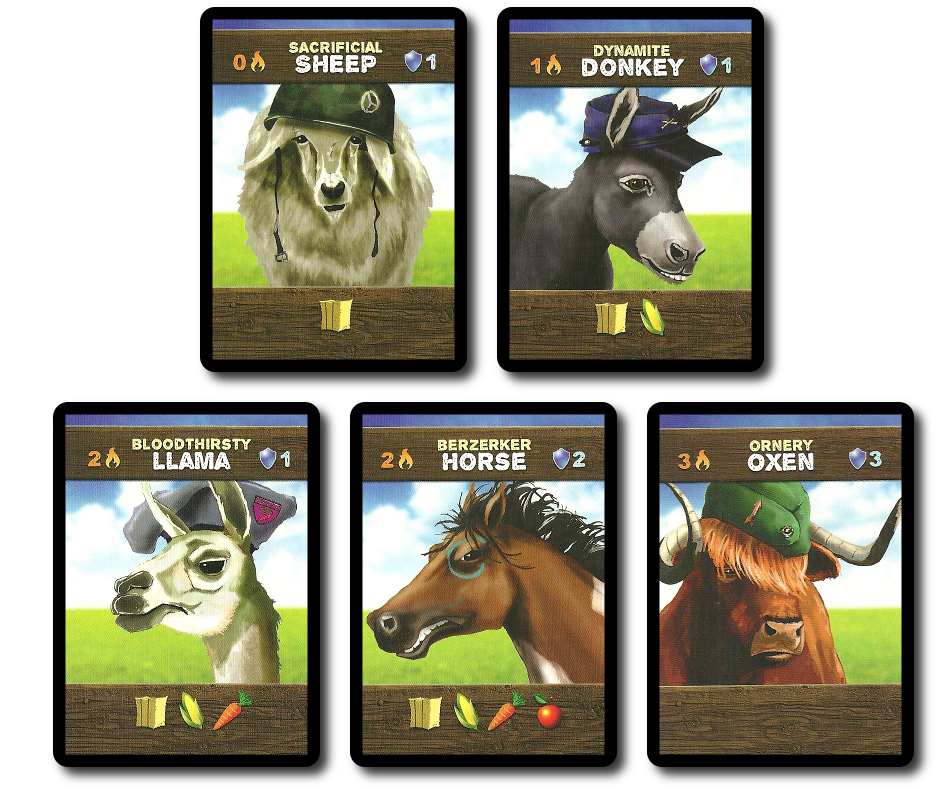
Special Forces Cards
Where the Troop cards are available to all players, each player has their own Special Forces cards that are specific to their faction. They are also limited. Once the Special Forces card is taken out, it’s removed from the game where the Troop cards are unlimited in number.
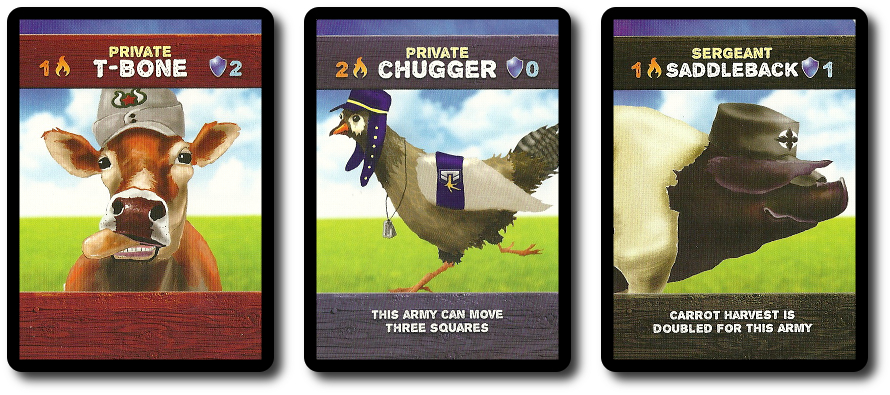
Special Forces cards are purchased using Resources in the same way the Troop cards were. The player’s Faction board lists the name and required Resource tokens for each Special Forces card. The player pays the Resource tokens, takes the Special Forces card from their hand, and bring it into play. Some Special Force cards provide special benefits. Any noted benefits are only available to the Army token the Special Force card is attached to.
Assigning Soldiers
When a Troop and Special Forces card is purchased, it’s immediately placed underneath 1 of the player’s 3 General cards. All cards under a General card are “attached” and move with the Army token that represents the General card. Each General card can only have 5 cards attached to it, however. The player can have any mix of Troop and Special Forces cards they like attached to the General card as long as the total number of those cards does not exceed 5.
Transferring Soldiers
Once a card is attached to a General card, it can only be removed if it selected as a casualty or transferred during this phase. Players can only transfer soldiers from one General card to another AFTER they have finished purchasing and assigning cards. This means a player cannot transfer a card to one general and then purchase a card to replace it.
Furthermore, this is not a swap. The player is only able to transfer 1 card, be it Troop or Special Forces. To make it even more difficult, the 2 General cards that are transferring must be physically adjacent to each other on the game board or on the “Barn” Board tile, as well.
In short, it’s not easy and takes a lot of logistical thinking up front.
The player’s turn is now over. The game continues with the next player in turn order sequence, taking their turn starting with phase 1 noted above.
Mule Kicking It Up a Notch
During a player’s turn, they can announce that they are forming a super army. This is only possible if the player locates all their Army tokens on their “Barn” Board tile. All 3 Army tokens are then removed and replaced with 1 really big Super Army token. The player now only has this one token to move during their turn, but they cannot move the Super Army token on the same turn it was created.
The player with the Super Army can then use their Resource tokens to marshal any new cards. In total, the Super Army cannot have any more than 15 cards attached to it (5 per general). Any remaining Resource tokens not spent and the General cards are now discarded. All Troop and Special Forces cards remain.
The player then draws 1 Battle Plan card, which is an awful lot like a Command card, but much more powerful.
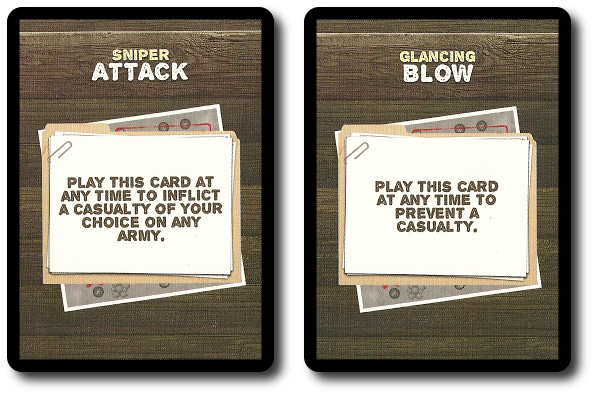
Finally, the player takes their Faction board and flips it over revealing the “Battle Board” side. This side of the Faction board keeps track of the Super Army’s attack and defense strength. The “1 Star” Army token is used to keep track of the Super Army’s attack value and the “3 Star” Army token is used to keep track of the Super Army’s defense value. Whatever number the Army token is covering up is the number value used. A Super Army’s starting attack and defense value is determined by adding the attack and defense values of all the Troop and Super Forces cards attached to it.

Super? Sure! But Not Unstoppable!
The Super Army token is played a bit differently than the Army tokens.
- Super Armies cannot harvest – this phase is skipped on the player’s turn
- Super Armies can move up to 3 Board tiles – all movement restrictions still apply
- Super Armies can enter opponent’s “Barn” Board tiles – you cannot hide from the Super Army!
- Multiple Army tokens can fight 1 Super Army token, but the Army tokens must all belong to the same faction
- Super Armies use 2 dice instead of 1 when attacking and defending – a roll of “12” is an automatic victory, but a roll of “2” is an automatic lose
- Super Armies cause so much damage, they inflict 2 casualties when attacking and defending
- Super Armies destroy (remove from game) any Army tokens that do not have any Troops or Special Forces cards attached to them
GOOD GRIEF! So how do you stop this giant animal war machine? It’s not easy, but it can be done. If a Super Army ever loses all of its Troop and Special Forces cards, the entire faction the Super Army belongs to is out of the game. Forever. Good riddance.
My Enemy’s Enemy is My Friend (Kind Of)
And now for some good news. Opponents can set aside their differences to form a temporary alliance. They can then perform a joint attack against another Super Army.
Conducting a joint attack is pretty simple. When a player declares an attack, any other Super Armies that want in on that action and are adjacent to the defending Super Army (i.e. the Super Army that is being attacked) can join the battle.
The player who initiated the attack rolls the dice and adds the strength of the Troop and Special Forces cards they have and the combined strength from any other opponent who joined in on the attack.
There is a downside to helping out. Any player who joins a joint attack loses their next turn. Only those players who join the campaign suffer this penalty. The player who started the joint attack does not. Put another way, if you join in out of turn, you lose your turn.
There is also a silver lining to a joint battle for the player who is being ganged up on. If the defender loses the attack, they will remove 2 casualties as usually. However, if they win, all the attackers (which includes the player who initiated the attack and those who joined the joint attack) suffer 2 casualties.
Winning the Game
How do you win? It’s simple. You remove every faction from the game board but yours. If you are the last player with forces down on the farm, you dominate all.
To learn more, visit the game’s website.
Final Word
The game was found to be easy to learn, but frustrating to play, according to the Child Geeks. As one Child Geek put it, “I never have enough resources to buy more animal soldiers!” Resources are tight in Livestock Uprising, making any Board tile with a Resource symbol a hotly contested battleground. But a number of our older Child Geeks liked this and thought it worked wonderfully. According to one Child Geek, “The resources are not only necessary to build your army, but they are also needed to gain additional troops that can find the next best resource. I like that and it gives me a reason to move around the game board instead of just fighting.” At every age and skill level, the Child Geeks found Livestock Uprising to be a game that was just too slow for them. It takes time to build up resources, time to build an army, and each defeat in a battle represents many minutes of positioning and resource gathering wasted. It would be incorrect to say that Livestock Uprising is a difficult game. All the Child Geeks understood how to play it beautifully. However, this is a game that takes a lot of time and a lot of patience. The Child Geeks ran out of both. Only the oldest and the most dedicated of Child Geeks played the game until the end. When it came time to vote, the Child Geeks rejected Livestock Uprising, finding it to be a game that demanded too much and took far too long.
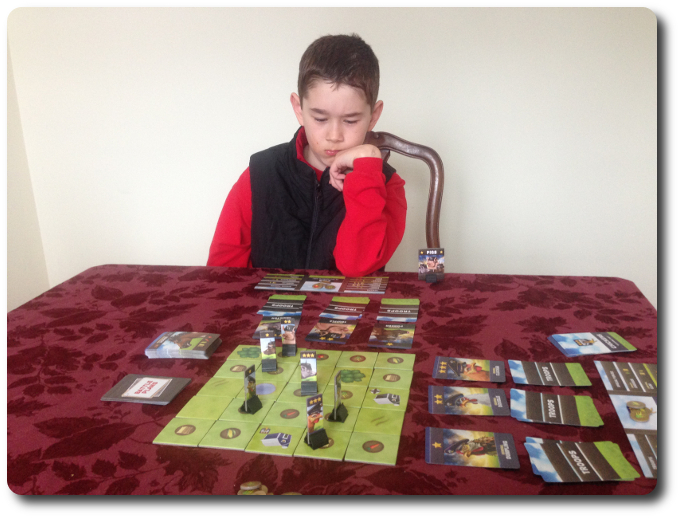
My son, the leader of the Pigs, contemplates his next move…
The Parent Geeks were surprised and somewhat delighted by the mix of casual game play and complexity. Livestock Uprising is most certainly a game anyone can learn, but the devil is in the details. All the Parent Geeks spotted this almost right from the start. As one Parent Geek put it, “I knew this game wasn’t going to be easy the second you said that only certain Troop cards could collect certain resources. That and what is shown on the Faction boards.” While the Child Geeks found this to be difficult to enjoy, the Parent Geeks saw it as a fun challenge. According to one Parent Geek, “It makes you think about every battle and you can’t just build any old army. I’m going to try to focus one group to be nothing more than resource gathers and make my other groups deadly animals!” All the Parent Geeks felt that there should have been some sort of exchange available and found the game suffering underneath its own weight without one. One frustrated Parent Geek said, “Good grief! I have hay coming out of my ears! Anyone want to trade hay for apples?” Of course, the players cannot. The Parent Geeks really struggled with this one, finding Livestock Uprising to be easy to learn, but it felt like too much effort to play it without an equal or greater return. As one Parent Geek astutely put it, “I think this is a game that demands a player’s time, attention, and a lot of patience. This is not about quick battles. This is a game about a long war.” When all the votes were in, the Parent Geeks gave Livestock Uprising a mixed approval.
The Gamer Geeks agreed with everything the Child and Parent Geeks said. However, they saw the game’s level of difficulty as part of the game play. According to one Gamer Geek, “I originally thought this was a Wargame, but I see now that this is really a Farming game with animals that go to war.” Or, really, it’s both. Players must collect resources, control areas of the board, and battle to maintain dominance. All the while, armies cannot be built unless specific Resource token types are available. It makes every thing more complicated and it’s often difficult to judge which is more important: the army or the resource they are sitting on. Regardless, the Gamer Geeks were enjoying themselves. They very much liked that they could form the Super Army whenever they wanted to, giving them the opportunity to skunk their opponents. As one Gamer Geek put it, “Timing is everything. If you merge to become a the super herd too late or too early, you could lose the game or win with ease.” Each endgame was brutal and quick, which made most of the Gamer Geeks pretty happy. When all the votes were in, the Gamer Geeks voted to approve Livestock Uprising. They found the game to be casual, but demanding, with a lot of room to play with strategies and tactics.
Personally, I’m a bit irritated with Livestock Uprising. It’s easy to learn and easy to teach. Non-gamers and Child Geeks quickly grasped the game’s rules without issue. Once it’s one the table, it’s anything but easy. The game is long, demands that the player take baby steps, and each set back is really a BIG set back. Every Troop card you lose not only impacts your ability to survive an attack, but it also directly affects your ability to gather resources. That one-two punch to the face contradicts the game’s perceived ease of play.
And that’s why I’m irritated. The game’s level of difficulty and length of play makes it impossible for me to get it to the table even if the game play is SO CRAZY SIMPLE! It’s like being given an opportunity to eat a juicy steak (sticking with the animal theme here, sort of), but given a plastic knife and a toothpick to eat it. It wouldn’t take long until you through your hands up in the air and said the hell with it. And that, my friends, is exactly what happened here. This juicy steak of a game is worth every bite, but the level of effort it takes chased people away.
I read somewhere that Livestock Uprising is like Chess. I disagree. This game is much more simple. I have also read that this game is for everyone. I do agree with this, but let’s keep it in perspective. Running a marathon is for everyone. Climbing a mountain is for everyone. Swimming with sharks is for everyone. But not everyone does these things. Same can be said for Livestock Uprising. This game can be learned and played by anyone. I just proved it. What I have also proved is that not everyone likes it or can finish it. Everyone can learn and start the game, but only the truly enthusiastic are going to finish it.
Would I recommend this game? Oh, goodness, yes. It’s a lot of fun. This just isn’t a game for the uninitiated. Which, in a way, makes it a game worth waiting for. If you play it too early, it’s going to burn you out. Livestock Uprising’s colorful illustrations, simple game play, and light rules disguise the game’s true animalistic nature that made many of our players scamper away like scared deer. If you got the time, do give Livestock Uprising a try. It’ll challenge and frustrate you, but it’s worth experiencing. Victories really feel like victories and every casualty feels baaaaad (again, sticking with the animal theme).
This game was given to Father Geek as a review copy. Father Geek was not paid, bribed, wined, dined, or threatened in vain hopes of influencing this review. Such is the statuesque and legendary integrity of Father Geek.



